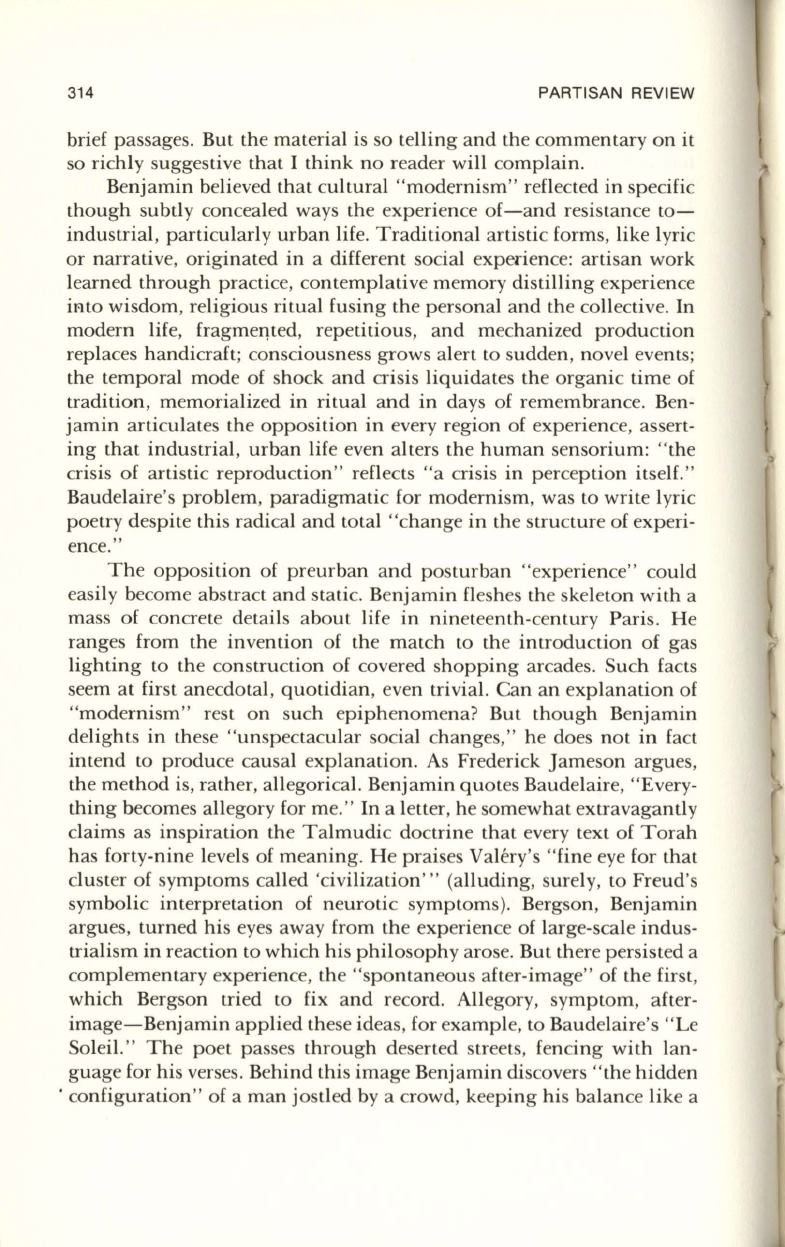
314
PARTISAN REVIEW
brief passages. But the material is so telling and the commentary on it
so richly suggestive that I think no reader will complain.
Benjamin believed that cultural "modernism" reflected in specific
though subtly concealed ways the experience of-and resistance
to–
industrial, particularly urban life. Traditional artistic forms , like lyric
or narrative, originated in a different social experience: artisan work
learned through practice, contemplative memory distilling experience
iI'lto wisdom, religious ritual fusing the personal and the collective.
In
modern life, fragmel1ted, repetitious, and mechanized production
replaces handicraft; consciousness grows alert
to
sudden, novel events;
the temporal mode of shock and crisis liquidates the organic time of
tradition, memorialized in ritual and in days of remembrance. Ben–
jamin articulates the opposition in every region of experience, assert–
ing that industrial, urban life even alters the human sensorium: "the
crisis of artistic reproduction" reflects "a crisis in perception itself. "
Baudelaire's problem, paradigmatic for modernism, was
to
write lyric
poetry despite this radical and total "change in the structure of experi–
ence."
The opposition of preurban and posturban "experience" cou ld
easily become abstract and static. Benjamin fleshes the skeleton with a
mass of concrete details about life in nineteenth-century Paris. He
ranges from the invention of the match to the introduction of gas
lighting to the construction of covered shopping arcades. Such facts
seem at first anecdotal, quotidian, even trivial. Can an explanation of
"modernism" rest on such epiphenomena? But though Benjamin
delights in these "unspectacular social changes," he does not in fact
intend to produce causal explanation. As Frederick Jameson argues,
the method is, rather, allegorical. Benjamin quotes Baudelaire, "Every–
thing becomes allegory for me."
In
a letter, he somewhat extravagantly
claims as inspiration the Talmudic doctrine that every text of Torah
has forty-nine levels of meaning. He praises Valery's "fine eye for that
cluster of symptoms called 'civilization'" (alluding, surely, to Freud's
symbolic interpretation of neurotic symptoms). Bergson, Benjamin
argues, turned his eyes away from the experience of large-scale indus–
trialism in reaction to which his philosophy arose. But there persisted a
complementary experience, the "spontaneous after-image" of the first,
which Bergson tried to fix and record. Allegory, symptom, after–
image-Benjamin applied these ideas, for example, to Baudelaire's "Le
Soleil." The poet passes through deserted streets, fencing with lan–
guage for his verses. Behind this image Benjamin discovers "the hidden
. configuration" of a man jostled by a crowd, keeping his balance like a


